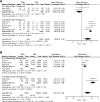Meta-analysis of the effects of smooth endoplasmic reticulum aggregation on birth outcome
- PMID: 33980189
- PMCID: PMC8117493
- DOI: 10.1186/s12884-021-03850-1
Meta-analysis of the effects of smooth endoplasmic reticulum aggregation on birth outcome
Abstract
Background: Smooth endoplasmic reticulum aggregation (SERa, SER+) has been reported to increase the risk of birth malformations and other abnormal outcomes, miscarriage, and perinatal complications. Other studies, however, suggest that SER+ embryos may develop into healthy infants. One report indicates that 25% of in vitro fertilization (IVF) centers discard SER+ oocytes. Thus, we investigated the effect of SER+ on birth outcomes in IVF and intracytoplasmic sperm injection.
Methods: We performed a literature search using PubMed, ScienceDirect, Cochrane, Embase, Ovid, and Scopus. We found a total of 1500 relevant studies between 1978 and 2020 and conducted a meta-analysis to study the effects of SER+ on live births, birth weight, and the number of metaphase II (MII) oocytes retrieved per cycle.
Results: Eleven eligible studies were included. If the SER+ zygote was evaluated again at the embryo transfer (ET) stage, SER+ did not affect birth or infant body weight. Stimulated ovaries producing too many oocytes per cycle were positively correlated with SER+ (OR = 1.28, 95% CI = 0.41-2.15; p = 0.004). SER+ was positively correlated with oocyte maturation rate, and observed heterogeneity in a previous meta-analysis was likely due to maternal age. Our data also showed that SER+ cycles produced more oocytes but achieved the same number of births from ET.
Conclusions: The use of SER+ MII oocytes is rare, with the collection of many oocytes in 1 cycle potentially inducing SER+. SER+ may be more common than we originally thought, as some SER+ is found in all oocytes. Although SER+ positively affected oocyte maturation rate, it did not affect births. We hypothesized that this is because the best embryos are chosen at every step of the process, and the oocytes with the poorest characteristics are removed. We therefore suggest a standard method for measuring SER+. Although embryos produced from SER+ cycles can be used, they should only be transferred when no other suitable embryos are available over several cycles.
Keywords: Aggregation; Births; Oocyte; Smooth endoplasmic reticulum (SER).
Conflict of interest statement
The authors declare that they do not have any conflicts of interest.
Figures





References
-
- Sfontouris IA, Lainas GT, Lainas TG, Faros E, Banti M, Kardara K, Anagnostopoulou K, Kontos H, Petsas GK, Kolibianakis EM. Complex chromosomal aberrations in a fetus originating from oocytes with smooth endoplasmic reticulum (SER) aggregates. Syst Biol Reprod Med. 2018;64(4):283–290. doi: 10.1080/19396368.2018.1466375. - DOI - PubMed
Publication types
MeSH terms
Grants and funding
LinkOut - more resources
Full Text Sources
Other Literature Sources

